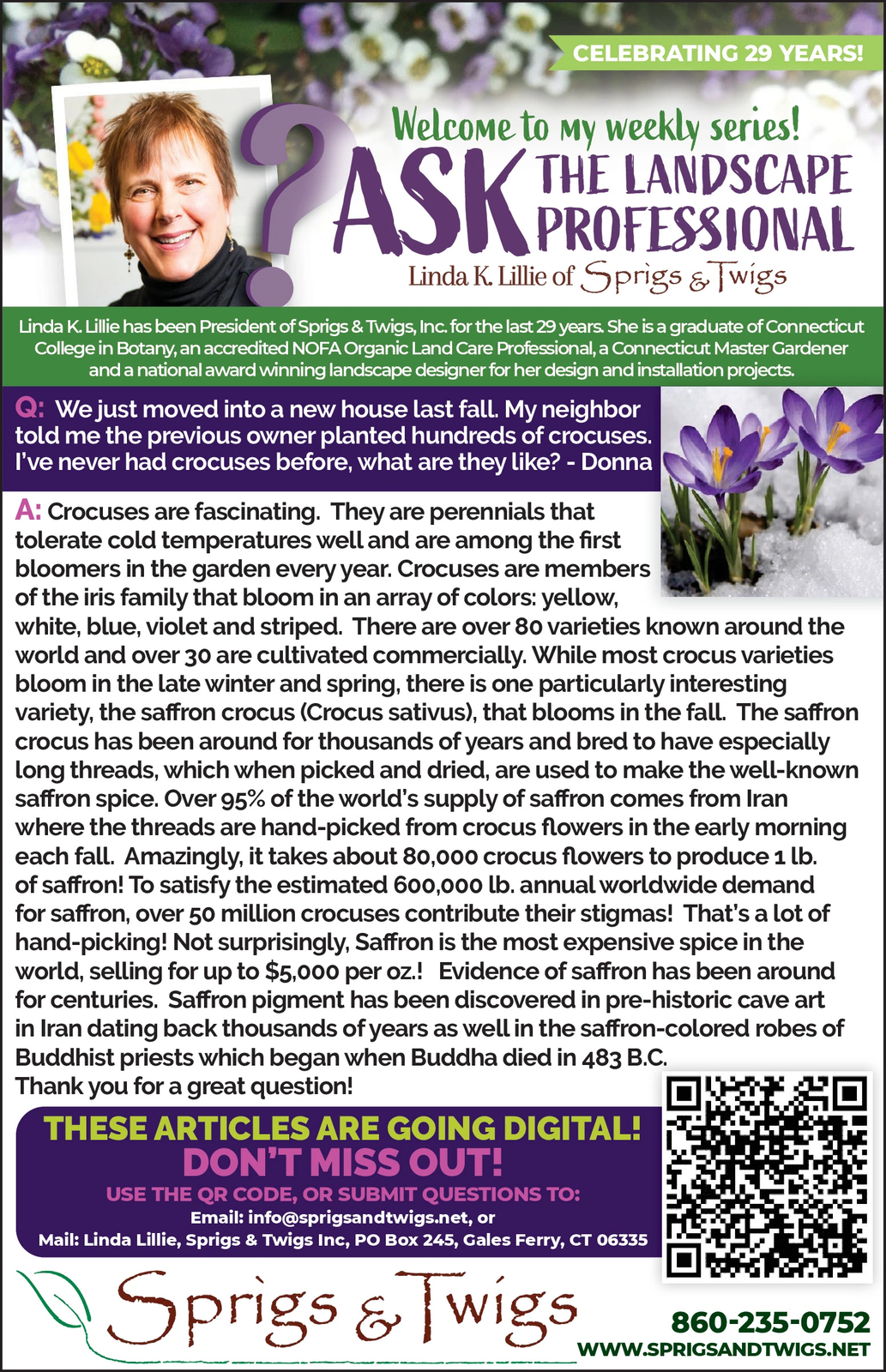Advertisement

-
Published Date
February 23, 2025This ad was originally published on this date and may contain an offer that is no longer valid. To learn more about this business and its most recent offers, click here.
Ad Text
CELEBRATING 29 YEARS! Welcome to my weekly series! LANDSCAPE ASK PROFESSIONAL Linda K. Lillie of Sprigs & Twigs Linda K. Lillie has been President of Sprigs & Twigs, Inc. for the last 29 years. She is a graduate of Connecticut College in Botany, an accredited NOFA Organic Land Care Professional, a Connecticut Master Gardener and a national award winning landscape designer for her design and installation projects. Q: We just moved into a new house last fall. My neighbor told me the previous owner planted hundreds of crocuses. I've never had crocuses before, what are they like? - Donna A: Crocuses are fascinating. They are perennials that tolerate cold temperatures well and are among the first bloomers in the garden every year. Crocuses are members of the iris family that bloom in an array of colors: yellow, white, blue, violet and striped. There are over 80 varieties known around the world and over 30 are cultivated commercially. While most crocus varieties bloom in the late winter and spring, there is one particularly interesting variety, the saffron crocus (Crocus sativus), that blooms in the fall. The saffron crocus has been around for thousands of years and bred to have especially long threads, which when picked and dried, are used to make the well-known saffron spice. Over 95% of the world's supply of saffron comes from Iran where the threads are hand-picked from crocus flowers in the early morning each fall. Amazingly, it takes about 80,000 crocus flowers to produce 1 lb. of saffron! To satisfy the estimated 600,000 lb. annual worldwide demand for saffron, over 50 million crocuses contribute their stigmas! That's a lot of hand-picking! Not surprisingly, Saffron is the most expensive spice in the world, selling for up to $5,000 per oz.! Evidence of saffron has been around for centuries. Saffron pigment has been discovered in pre-historic cave art in Iran dating back thousands of years as well in the saffron-colored robes of Buddhist priests which began when Buddha died in 483 B.C. Thank you for a great question! THESE ARTICLES ARE GOING DIGITAL! DON'T MISS OUT! USE THE QR CODE, OR SUBMIT QUESTIONS TO: Email: info@sprigsandtwigs.net, or Mail: Linda Lillie, Sprigs & Twigs Inc, PO Box 245, Gales Ferry, CT 06335 Sprigs & Twigs 860-235-0752 WWW.SPRIGSANDTWIGS.NET CELEBRATING 29 YEARS ! Welcome to my weekly series ! LANDSCAPE ASK PROFESSIONAL Linda K. Lillie of Sprigs & Twigs Linda K. Lillie has been President of Sprigs & Twigs , Inc. for the last 29 years . She is a graduate of Connecticut College in Botany , an accredited NOFA Organic Land Care Professional , a Connecticut Master Gardener and a national award winning landscape designer for her design and installation projects . Q : We just moved into a new house last fall . My neighbor told me the previous owner planted hundreds of crocuses . I've never had crocuses before , what are they like ? - Donna A : Crocuses are fascinating . They are perennials that tolerate cold temperatures well and are among the first bloomers in the garden every year . Crocuses are members of the iris family that bloom in an array of colors : yellow , white , blue , violet and striped . There are over 80 varieties known around the world and over 30 are cultivated commercially . While most crocus varieties bloom in the late winter and spring , there is one particularly interesting variety , the saffron crocus ( Crocus sativus ) , that blooms in the fall . The saffron crocus has been around for thousands of years and bred to have especially long threads , which when picked and dried , are used to make the well - known saffron spice . Over 95 % of the world's supply of saffron comes from Iran where the threads are hand - picked from crocus flowers in the early morning each fall . Amazingly , it takes about 80,000 crocus flowers to produce 1 lb. of saffron ! To satisfy the estimated 600,000 lb. annual worldwide demand for saffron , over 50 million crocuses contribute their stigmas ! That's a lot of hand - picking ! Not surprisingly , Saffron is the most expensive spice in the world , selling for up to $ 5,000 per oz . ! Evidence of saffron has been around for centuries . Saffron pigment has been discovered in pre - historic cave art in Iran dating back thousands of years as well in the saffron - colored robes of Buddhist priests which began when Buddha died in 483 B.C. Thank you for a great question ! THESE ARTICLES ARE GOING DIGITAL ! DON'T MISS OUT ! USE THE QR CODE , OR SUBMIT QUESTIONS TO : Email : info@sprigsandtwigs.net , or Mail : Linda Lillie , Sprigs & Twigs Inc , PO Box 245 , Gales Ferry , CT 06335 Sprigs & Twigs 860-235-0752 WWW.SPRIGSANDTWIGS.NET
